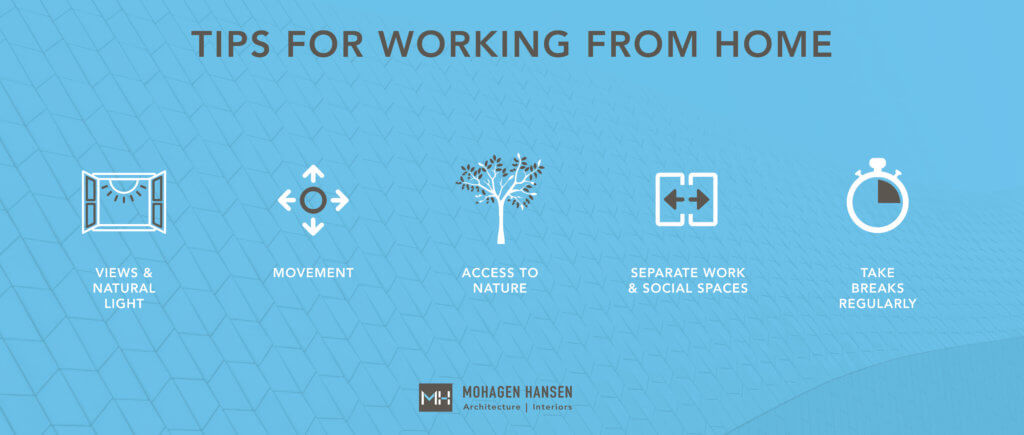Similar to many companies, Mohagen Hansen has quickly transitioned to working remotely. This abrupt change introduced a new routine and a new “normal” which, is pretty abnormal for most of us. We understand everyone is trying to assemble a routine and navigate how they can best do their jobs in new work environments. Our goal for this post is to give insight on some of the important aspects we consider as we design a new office workspace and give you actionable items to integrate into your daily lives.
Views and Natural Light
Daylight, daylight, daylight. Natural light has been proven to boost moods, creativity and productivity, so when we begin an office project, our goal is to configure a space to allow as much natural light to pour into the space as possible. Sometimes this means removing private offices around the perimeter to allow a balanced distribution of light throughout the space. Finishes such as paint color, wall coverings and workstation panel height can assist in allowing light to bounce and move throughout the area.
By setting up your home office next to natural light, you can set yourself up to be happier, more productive and more positive. Consider configuring one of the lightest rooms in your house to be your new at home office. The time investment to reconfiguring this room could make all the difference in your workday. If working in a room with natural light isn’t an option for you, try going outside or standing by a window when taking breaks.
Movement
Throughout the design process, we aim to thoroughly understand a client’s workflow process, how multiple departments work together and what amenity spaces are important to the client. Office corridors are designed to allow room for two-way traffic and provide multiple routes to reach the same destination.
Think back to your typical day in the office. Most days included walking to the break room, moving from meeting room to meeting room, and workstation to workstation for impromptu discussions. To stay truer to a typical day, try walking up and down a flight of stairs in your home or completing a quick, simple exercise before a virtual meeting. These movements can take the place of travel from meeting to meeting in your normal office environment.
Access to Nature
Whenever possible, our design teams aim to integrate natural elements into a workspace. Some examples of these materials include natural textures and patterns. By integrating natural elements, it not only improves the aesthetics of a space, but also improves the lives of the people who work there every day.
If the room you have set up to be your home office doesn’t usually house any plants, maybe a houseplant from another area of your living space can have a temporary relocation. Placing greenery and living plants near your space provides you with a subtle change that could have a great impact on productivity and mood.
Separate work and social spaces
When we design an office space, we implement a variety of spaces throughout the floor plan. These spaces could include: a break room, individual workstations, collaboration areas, staff amenity spaces, etc. The team designs and configures each space uniquely to fit its function. For example, people that seek minimal distraction, are not likely to sit and work in the breakroom. Breakrooms are designed to aid in conversations between employees, and act as a real “break” from focused work.
Similarly, while in your home workspace, if possible, be diligent with where you are completing work. Designate specific “work and focus” areas and other “relax and socialize” areas. We’ve heard many people say, “I’ve had a tough time turning off work now that work is home and home is work”. By designating these areas in your home you can avoid staying in the “work and focus” room for excessive hours of the day and achieve balance by spending time in the “relax and socialize” areas. If one doesn’t have separate spaces, try packing up work materials at the end of the workday.
Take breaks regularly
For many, working from home makes them feel “more productive”. This is probably true. Think about being at the office – coworkers moving by your desk, going from meeting to meeting, making a trip to the break room and impromptu spurts of conversations with coworkers.
It’s important to remember these “typical daily occurrences” and to integrate them into your normal day. Call a coworker to have a quick chat, allow yourself to take a 10-minute break to discuss something with a person you’re quarantining with, or walk to the kitchen to keep your water glass full.
If you’re finding it difficult to remember to take breaks, try setting a timer! When focused on a specific task, hours can pass before you look up from your screen. Timers can help you prioritize taking quick breaks to increase your productivity and movement.
This is new for many of us, so test different strategies to see what works best for you. We hope these actionable items can help you navigate these challenging times and help you stay productive and positive in your new work environment!















